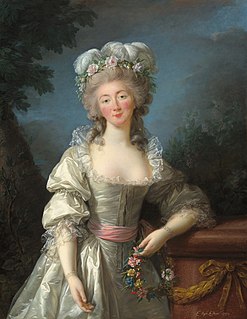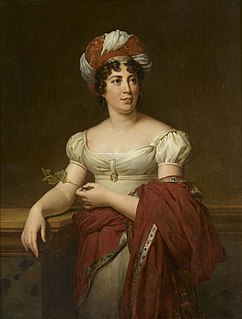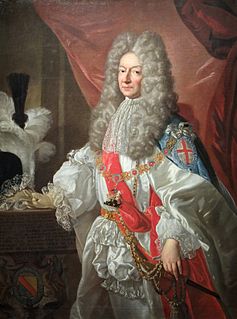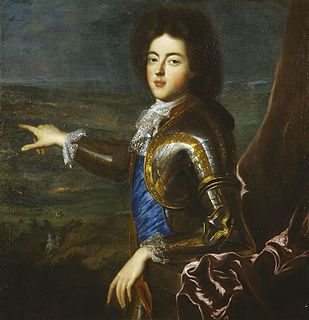Related Research Articles

Madama Butterfly is an opera in three acts by Giacomo Puccini, with an Italian libretto by Luigi Illica and Giuseppe Giacosa.

Madame Bovary, originally published as Madame Bovary: Provincial Manners, is the debut novel of French writer Gustave Flaubert, published in 1856. The eponymous character lives beyond her means in order to escape the banalities and emptiness of provincial life.

Jeanne Bécu, Comtesse du Barry was the last maîtresse-en-titre of King Louis XV of France. She was executed, by guillotine, during the French Revolution due to accounts of treason—particularly being suspected to assist émigrés flee from the Revolution.

Anne Louise Germaine de Staël-Holstein, commonly known as Madame de Staël, was a French woman of letters and political theorist, the daughter of banker and French finance minister Jacques Necker and Suzanne Curchod, a leading salonnière. She was a voice of moderation in the French Revolution and the Napoleonic era up to the French Restoration. She was present at the Estates General of 1789 and at the 1789 Declaration of the Rights of Man and of the Citizen. Her intellectual collaboration with Benjamin Constant between 1794 and 1810 made them one of the most celebrated intellectual couples of their time. She discovered sooner than others the tyrannical character and designs of Napoleon. For many years she lived as an exile – firstly during the Reign of Terror and later due to personal persecution by Napoleon.

Françoise d'Aubigné, known first as Madame Scarron and subsequently as Madame de Maintenon, was a French noblewoman who secretly married King Louis XIV. Although she was never considered queen of France, she was one of the King's closest advisers and the royal children's governess. In 1684, she founded the Maison royale de Saint-Louis, a school for girls from poorer noble families.

Antoine Nompar de Caumont, duc de Lauzun was a French courtier and soldier. He was the only love interest of the "greatest heiress in Europe", Anne Marie Louise d'Orléans, Duchess of Montpensier, cousin of Louis XIV.

MonsieurPhilippe I, Duke of Orléans was the younger son of Louis XIII of France and his wife, Anne of Austria. His older brother was the "Sun King", Louis XIV. Styled Duke of Anjou from birth, Philippe became Duke of Orléans upon the death of his uncle Gaston in 1660. In 1661, Philippe also received the Dukedoms of Valois and Chartres. Following Philippe's victory in battle in 1671, Louis XIV added the dukedom of Nemours, the marquisates of Coucy and Folembray, and the countships of Dourdan and Romorantin.

Marie-Thérèse Charlotte was the eldest child of King Louis XVI and Queen Marie Antoinette of France and briefly disputed Queen of France in 1830. She was the only child of her parents to reach adulthood. In 1799 she married her cousin Louis Antoine, Duke of Angoulême, the eldest son of Charles, Count of Artois.

Philibert, Count de Gramont, was a French nobleman, known as the protagonist of the Mémoires written by Anthony Hamilton. He was a younger half-brother of Antoine III of Gramont and uncle of Catherine Charlotte de Gramont, princess of Monaco.

These Old Shades (1926) is a Georgian romance novel written by British novelist Georgette Heyer (1902–1974). It was an instant success, and established her as a writer. It falls into the category of historical romance.

Élisabeth Philippe Marie Hélène of France was a French princess. She was the youngest child of Louis, Dauphin of France, and Duchess Maria Josepha of Saxony, and she was a sister of King Louis XVI. Élisabeth's father, the Dauphin, was the son and heir of King Louis XV. Élisabeth remained beside her brother and his family during the French Revolution and was executed at Place de la Révolution in Paris during the Terror. She is regarded by the Catholic Church as a martyr and was declared a Servant of God by Pope Pius XII.

The 4th House of Orléans, sometimes called the House of Bourbon-Orléans to distinguish it, is the fourth holder of a surname previously used by several branches of the Royal House of France, all descended in the legitimate male line from the dynasty's founder, Hugh Capet. The house was founded by Philippe I, Duke of Orléans, younger son of Louis XIII and younger brother of Louis XIV, the "Sun King".

Pierre Toussaint was a Haitian-American hairdresser, philanthropist, and former slave brought to New York City by his owners in 1787. Freed in 1807 after the death of his mistress, Pierre took the surname of "Toussaint" in honor of the hero of the Haitian Revolution. In 1996, he was declared "Venerable" by Pope John Paul II.

Louis-Auguste de Bourbon, duc du Maine was an illegitimate son of Louis XIV and his official mistress, Madame de Montespan. The king's favourite son, he was the founder of the semi-royal House of Bourbon-Maine named after his title and his surname.
The Duke's Mistress is a Caroline era stage play, a tragicomedy written by James Shirley and first published in 1638. It was the last of Shirley's plays produced before the major break in his career: with the closing of the London theatres due to bubonic plague in May 1636, Shirley left England for Ireland, where he worked under John Ogilby at the Werburgh Street Theatre in Dublin for four years.

A prince du sang is a person legitimately descended in male line from a sovereign. The female equivalent was princess of the blood, being applied to the daughter of a prince of the blood. The most prominent examples include members of the French royal line, but the term prince of the blood has been used in other families more generally, for example among the British royal family and when referring to the Shinnōke.

Louise Élisabeth de Bourbon was a daughter of Louis III de Bourbon, Prince of Condé, and his wife, Louise Françoise de Bourbon, légitimée de France, a legitimised daughter of King Louis XIV of France and his famous mistress, Madame de Montespan.

Princess Marie Thérèse Louise of Savoy was a member of the Savoy-Carignano cadet branch of the House of Savoy. She was married at the age of 17 to Louis Alexandre de Bourbon-Penthièvre, Prince de Lamballe, the heir to the greatest fortune in France. After her marriage, which lasted a year, she went to court and became the confidante of Queen Marie Antoinette. She was killed in the massacres of September 1792 during the French Revolution.

Scarlet and Black is a British four-part television drama series first aired in 1993 on BBC 1 by the BBC with a cast including Ewan McGregor and Rachel Weisz. The series was adapted by Stephen Lowe from the novel The Red and the Black (1830) by French writer Stendhal. The story follows an ambitious, but impoverished young man, who seduces women of high social standing in order to improve his prospects.

Caroline Massin was a French seamstress known for her tempestuous marriage with the philosopher Auguste Comte during the most creative period of his life. Comte was mentally unstable and had jealous fantasies about his wife's infidelities. Early in the marriage he broke down and was confined to an asylum for several months. The marriage continued to be strained, with constant money worries. Although Caroline supported her husband and believed in his genius, Comte could never accept her independence. They separated after 17 years. In his last years Comte wrote an appendix to his will in which he accused Caroline of having been a prostitute, The slur was later repeated by his followers. After his death Caroline encouraged a sympathetic biographer of Comte and helped launch a magazine devoted to his philosophy of positivism.
References
- The Tales of Henry James by Edward Wagenknecht (New York: Frederick Ungar Publishing Co. 1984) ISBN 0-8044-2957-X
- A Henry James Encyclopedia by Robert L. Gale (New York: Greenwood Press 1989) ISBN 0-313-25846-5
- A Companion to Henry James Studies edited by Daniel Fogel (Westport, CT: Greenwood Press 1993) ISBN 0-313-25792-2